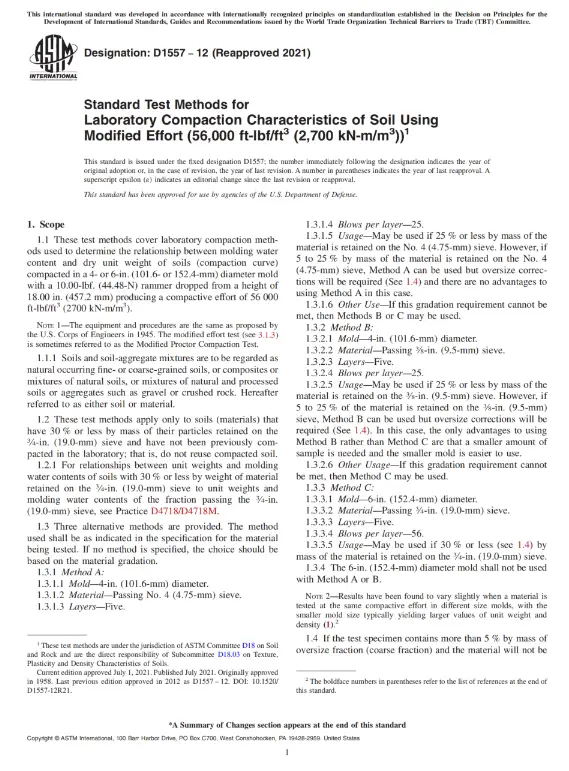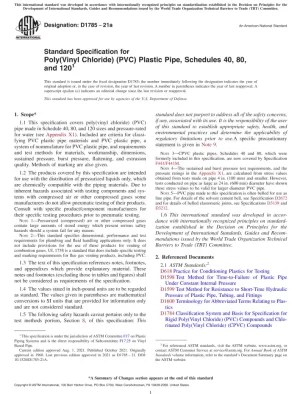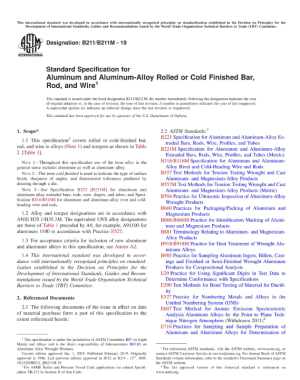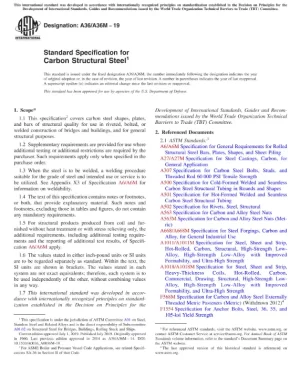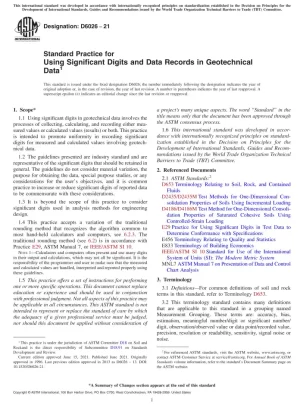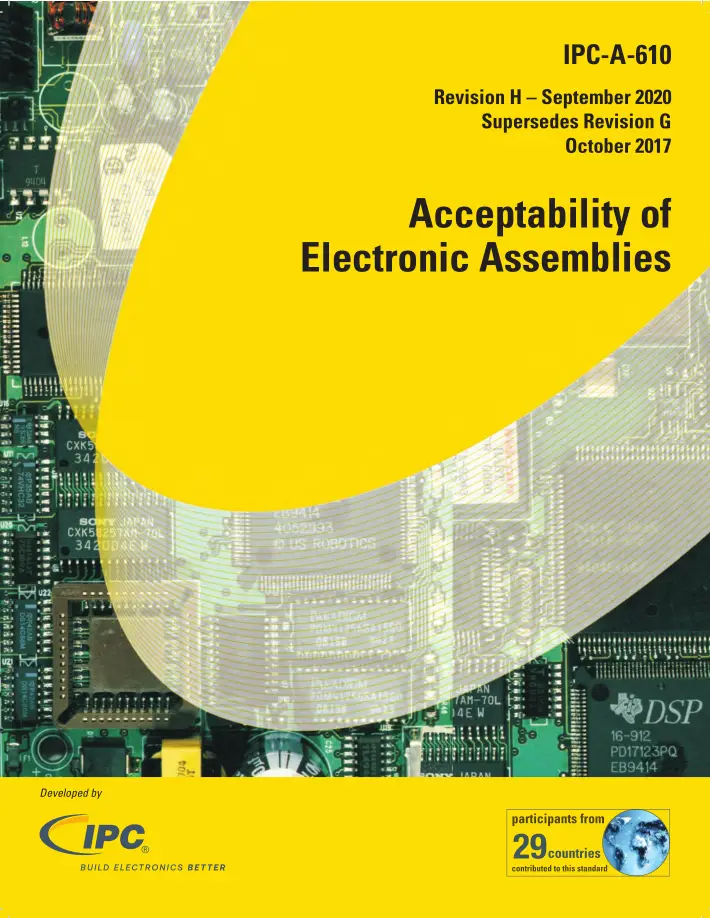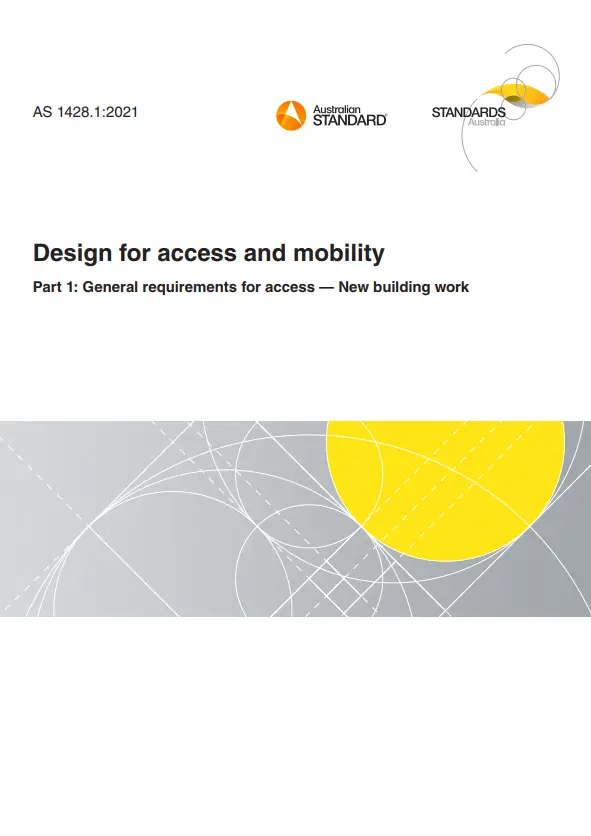ASTM D1557, 2012 Edition – Standard Test Methods for Laboratory Compaction Characteristics of Soil Using Modified Effort (56,000 ft-lbf/ft3 (2,700 kN-m/m3))
These test methods cover laboratory compaction methods used to determine the relationship between molding water content and dry unit weight of soils (compaction curve) compacted in a 4- or 6-in. (101.6- or 152.4-mm) diameter mold with a 10.00-lbf. (44.48-N) rammer dropped from a height of 18.00 in. (457.2 mm) producing a compactive effort of 56 000 ft-lbf/ft3 (2700 kN-m/m3).
NOTE 1—The equipment and procedures are the same as proposed by the U.S. Corps of Engineers in 1945. The modified effort test (see 3.1.3) is sometimes referred to as the Modified Proctor Compaction Test.
Soils and soil-aggregate mixtures are to be regarded as natural occurring fine- or coarse-grained soils, or composites or mixtures of natural soils, or mixtures of natural and processed soils or aggregates such as gravel or crushed rock. Hereafter referred to as either soil or material.
These test methods apply only to soils (materials) that have 30 % or less by mass of their particles retained on the 3⁄4-in. (19.0-mm) sieve and have not been previously compacted in the laboratory; that is, do not reuse compacted soil.
For relationships between unit weights and molding water contents of soils with 30 % or less by weight of material retained on the 3⁄4-in. (19.0-mm) sieve to unit weights and molding water contents of the fraction passing the 3⁄4-in. (19.0-mm) sieve, see Practice D4718/D4718M.
Three alternative methods are provided. The method used shall be as indicated in the specification for the material being tested. If no method is specified, the choice should be based on the material gradation.
Method A:
Mold—4-in. (101.6-mm) diameter.
Material—Passing No. 4 (4.75-mm) sieve.
Layers—Five.
Blows per layer—25.
Usage—May be used if 25 % or less by mass of the material is retained on the No. 4 (4.75-mm) sieve. However, if 5 to 25 % by mass of the material is retained on the No. 4 (4.75-mm) sieve, Method A can be used but oversize corrections will be required (See 1.4) and there are no advantages to using Method A in this case.
Other Use—If this gradation requirement cannot be met, then Methods B or C may be used.
Method B:
Mold—4-in. (101.6-mm) diameter.
Material—Passing 3⁄8-in. (9.5-mm) sieve.
Layers—Five.
Blows per layer—25.
Usage—May be used if 25 % or less by mass of the material is retained on the 3⁄8-in. (9.5-mm) sieve. However, if 5 to 25 % of the material is retained on the 3⁄8-in. (9.5-mm) sieve, Method B can be used but oversize corrections will be required (See 1.4). In this case, the only advantages to using Method B rather than Method C are that a smaller amount of sample is needed and the smaller mold is easier to use.
Other Usage—If this gradation requirement cannot be met, then Method C may be used.
Method C:
Mold—6-in. (152.4-mm) diameter.
Material—Passing 3⁄4-in. (19.0-mm) sieve.
Layers—Five.
Blows per layer—56.
Usage—May be used if 30 % or less (see 1.4) by mass of the material is retained on the 3⁄4-in. (19.0-mm) sieve.
The 6-in. (152.4-mm) diameter mold shall not be used with Method A or B.
NOTE 2—Results have been found to vary slightly when a material is tested at the same compactive effort in different size molds, with the smaller mold size typically yielding larger values of unit weight and density (1).2
If the test specimen contains more than 5 % by mass of oversize fraction (coarse fraction) and the material will not be included in the test, corrections must be made to the unit weight and molding water content of the test specimen or to the appropriate field in-place unit weight (or density) test specimen using Practice D4718/D4718M.
This test method will generally produce a well-defined maximum dry unit weight for non-free draining soils. If this test method is used for free-draining soils the maximum unit weight may not be well defined, and can be less than obtained using Test Methods D4253.
All observed and calculated values shall conform to the guidelines for significant digits and rounding established in Practice D6026, unless superseded by these test methods.
For purposes of comparing measured or calculated value(s) with specified limits, the measured or calculated value(s) shall be rounded to the nearest decimal or significant digits in the specified limits.
The procedures used to specify how data are collected/recorded or calculated in this standard are regarded as the industry standard. In addition, they are representative of the significant digits that generally should be retained. The procedures used do not consider material variation, purpose for obtaining the data, special purpose studies, or any considerations for the user’s objectives; it is common practice to increase or reduce significant digits of reported data to be commensurate with these considerations. It is beyond the scope of these test methods to consider significant digits used in analytical methods for engineering design.
The values in inch-pound units are to be regarded as the standard. The values stated in SI units are provided for information only, except for units of mass. The units for mass are given in SI units only, g or kg.
It is common practice in the engineering profession to concurrently use pounds to represent both a unit of mass (lbm) and a force (lbf). This implicitly combines two separate systems of units; that is, the absolute system and the gravitational system. It is scientifically undesirable to combine the use of two separate sets of inch-pound units within a single standard. These test methods have been written using the gravitational system of units when dealing with the inch-pound system. In this system, the pound (lbf) represents a unit of force (weight). However, the use of balances or scales recording pounds of mass (lbm) or the recording of density in lbm/ft3 shall not be regarded as a nonconformance with this standard.
This standard does not purport to address all of the safety concerns, if any, associated with its use. It is the responsibility of the user of this standard to establish appropriate safety, health, and environmental practices and determine the applicability of regulatory limitations prior to use.
Warning—Mercury has been designated by EPA and many state agencies as a hazardous material that can cause central nervous system, kidney, and liver damage. Mercury, or its vapor, may be hazardous to health and corrosive to materials. Caution should be taken when handling mercury and mercury containing products. See the applicable product Material Safety Data Sheet (MSDS) for details and EPA’s website for additional information. Users should be aware that selling mercury or mercury containing products or both into your state may be prohibited by state law.
This international standard was developed in accordance with internationally recognized principles on standardization established in the Decision on Principles for the Development of International Standards, Guides and Recommendations issued by the World Trade Organization Technical Barriers to Trade (TBT) Committee.
2 The boldface numbers in parentheses refer to the list of references at the end of this standard.
General Product Information:
| Revision | 2012 Edition |
| Document Type | |
| Document Language | English |
| Pages | 13 |
| Publisher | ASTM International (ASTM) |
| Status | Current |

